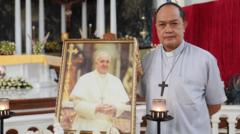As the Vatican opens its doors to a gathering of 133 red-robed cardinals, the atmosphere is one of reverence and anticipation. This conclave, marking the first papal election in over a decade since Pope Francis's recent passing, represents a significant moment for the church, which faces challenges related to finances, historical misconduct, and divergent ideological factions.
**Cardinals Gather in Rome for Historic Papal Conclave Following Pope Francis's Passing**

**Cardinals Gather in Rome for Historic Papal Conclave Following Pope Francis's Passing**
A pivotal moment for the Catholic Church unfolds as cardinals prepare to select a new pope amidst calls for reform and unity.
**The Proceedings of the Conclave and Possible Outcomes**
Commencing their proceedings in the iconic Sistine Chapel, the cardinals, sworn to secrecy, will engage in a series of votes to elect a successor with a leadership style reflective of the current times. The initial voting is set to indicate the degree of consensus among the cardinals—a crucial aspect of the papal decision-making process.
Often characterized by intricate rituals and spiritual reflection, the conclave’s votes will determine whether a candidate emerges with a commanding two-thirds majority. Experts suggest that the cardinal voting body’s mixed backgrounds could lead to potential fragmentation, complicating the selection process.
**Candidates in the Spotlight: Who Might Lead the Church Next?**
The spotlight is particularly on potential frontrunners Cardinal Pietro Parolin, known for his administrative experience as Francis's deputy, and Cardinal Luis Antonio Tagle, who represents a progressive surge from the rapidly growing congregation in the Philippines. Predictions suggest the conclave could become a referendum on the legacy of Francis, as competing visions for the church's path forward emerge—from attempts to retain traditional values to more accepting and inclusive perspectives.
**Contemplating Spiritual Responsiveness Amidst Cultural Dynamics**
The significance of the Sistine Chapel as a historical site infuses the voting process with deeper meaning, enshrining the responsibilities the cardinals now bear. Cardinal Giovanni Battista Re's call for a leader who can navigate the complexities of the modern world echoes the sentiments of many insiders, as does the necessity for unity amidst diversity within the church.
As the world awaits the outcome from the hallowed attic of the Vatican, where ballots will literally smoke out judgment, the time-honored tradition of papal selection is poised to unfold like a modern-day drama, reverberating far beyond the walls of the chapel.
**Anticipated Developments During the Conclave**
Should the cardinals not reach consensus on the first day, they will retreat to Vatican guesthouses for the night, returning the next day to engage in further rounds of votes, with the iconic smoke signals indicating the outcome of their deliberations. If white smoke billows from the chimney atop the Sistine Chapel, signaling the election of the new pope, it will not only represent a new chapter for the church but also a momentous occasion in a world increasingly attuned to the complexities of faith and leadership.
Commencing their proceedings in the iconic Sistine Chapel, the cardinals, sworn to secrecy, will engage in a series of votes to elect a successor with a leadership style reflective of the current times. The initial voting is set to indicate the degree of consensus among the cardinals—a crucial aspect of the papal decision-making process.
Often characterized by intricate rituals and spiritual reflection, the conclave’s votes will determine whether a candidate emerges with a commanding two-thirds majority. Experts suggest that the cardinal voting body’s mixed backgrounds could lead to potential fragmentation, complicating the selection process.
**Candidates in the Spotlight: Who Might Lead the Church Next?**
The spotlight is particularly on potential frontrunners Cardinal Pietro Parolin, known for his administrative experience as Francis's deputy, and Cardinal Luis Antonio Tagle, who represents a progressive surge from the rapidly growing congregation in the Philippines. Predictions suggest the conclave could become a referendum on the legacy of Francis, as competing visions for the church's path forward emerge—from attempts to retain traditional values to more accepting and inclusive perspectives.
**Contemplating Spiritual Responsiveness Amidst Cultural Dynamics**
The significance of the Sistine Chapel as a historical site infuses the voting process with deeper meaning, enshrining the responsibilities the cardinals now bear. Cardinal Giovanni Battista Re's call for a leader who can navigate the complexities of the modern world echoes the sentiments of many insiders, as does the necessity for unity amidst diversity within the church.
As the world awaits the outcome from the hallowed attic of the Vatican, where ballots will literally smoke out judgment, the time-honored tradition of papal selection is poised to unfold like a modern-day drama, reverberating far beyond the walls of the chapel.
**Anticipated Developments During the Conclave**
Should the cardinals not reach consensus on the first day, they will retreat to Vatican guesthouses for the night, returning the next day to engage in further rounds of votes, with the iconic smoke signals indicating the outcome of their deliberations. If white smoke billows from the chimney atop the Sistine Chapel, signaling the election of the new pope, it will not only represent a new chapter for the church but also a momentous occasion in a world increasingly attuned to the complexities of faith and leadership.





















